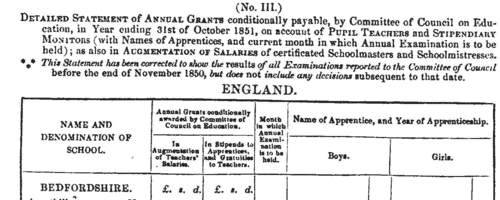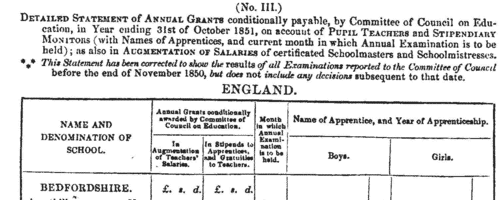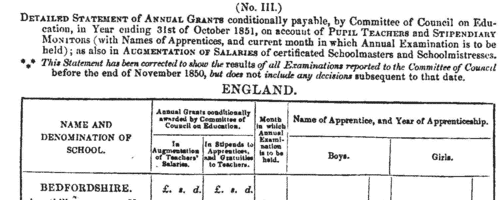Add this eBook to your basket to receive access to all 1,275 records. Our indexes include entries for the spelling wyatt. In the period you have requested, we have the following 1,275 records (displaying 771 to 780): These sample scans are from the original record. You will get scans of the full pages or articles where the surname you searched for has been found. Your web browser may prevent the sample windows from opening; in this case please change your browser settings to allow pop-up windows from this site.  Inhabitants of Newington in Surrey
(1851) Inhabitants of Newington in Surrey
(1851)
The 1851 census return for St Mary Newington, Surrey, registration district: St Peter Walworth sub-district: enumeration district 5: described as: "All that Part of the Parish of St. Mary Newington, which Comprises the South side of Hill St. from George St. to Montpelier St., West Side of Montpelier St., and North side of Beresford St." HO 107/1567. This area lay in the ecclesiastical district of St Peter Walworth, and in the borough of Lambeth. The addresses listed in the actual returns are 1 to 3, 11 to 15, 53, 69 to 74, 81 to 94, 99 to 101, 104 and 105, and 123 to 126 Hill Street; 1 and 2 Mary Ann Cottages; Hope Cottage; 1 and 2 Laurel Cottage; 2 to 5 and 9 Ebenezer Place; 1 to 8 Spring Cottages; 1 to 4 Alliance Cottage, Montpelier Street; 1 to 97 Beresford Street (including Prince Royal public house); 1 to 7 Kennington Street; and 1 to 5 St Georges Terrace, Beresford Street. | Sample scan, click to enlarge

|  Inhabitants of Newington in Surrey
(1851) Inhabitants of Newington in Surrey
(1851)
The 1851 census return for St Mary Newington, Surrey, registration district: St Peter Walworth sub-district: enumeration district 6: described as: "All that Part of the Parish of St. Mary Newington, which Comprises the south side of Beresford St., West side of Walworth Road to Grosvenor St. Including Brunswick Terrace, North Side of Grosvenor St., and North Terrace". HO 107/1567. This area lay in the ecclesiastical district of St Peter Walworth, and in the borough of Lambeth. The addresses listed in the actual returns are 1 to 3 Canterbury Terrace; 1 to 3 Oliver Cottages; 1 to 29 Flood's Terrace; Queen's Cottages; 1 and 2 Beresford Cottage; Lion Cottage;1 and 2 Rose Cottage(s); 1 to 34 Beresford Terrace; 1 to 28 Kennington Street; 1 to 8 Beresford Street; Brown's Cottage; 1 to 4 Williams Place; Barwick's Stables; 1 to 6 Williams Place (South); 1 to 16 Brunswick Terrace; 1 to 3 Brunswick Place; Brunswick Cottage; Grosvenor Cottage; 1 to 5 Grosvenor Place; 1 to 19 Grosvenor Street; and 1 to 6 North Terrace. | Sample scan, click to enlarge

|  Inhabitants of Southwark in Surrey
(1851) Inhabitants of Southwark in Surrey
(1851)
The 1851 census return for St George the Martyr, Southwark, registration district: London Road sub-district: enumeration district 10: described as: "London Road (south side), No 68 to No 1 and the Blind School - Albert Terrace - Gladstone St - Opposite Albert Terrace - Richmond Street - St George's Road (North side) including Preston House - Gladstone Place - Richmond Terrace - and West Place to the corner of Garden Row." This area lay in the parish of St George the Martyr, Southwark, ecclesiastical district of St Jude. The addresses listed in the actual returns are 1 to 68 London Road, Albert Arms, 1 to 5 Richmond Terrace, 1 to 26 Richmond Street, 1 to 16 Gladstone Street, 1 to 34 Albert Terrace, 1 to 4 West Place, 1 to 3 Richmond Place, 1 to 4 Gladstone Place, Preston House (St Georges Road) and the Blind School (London Road). The students at the Blind School are not included in this index. | Sample scan, click to enlarge

|  Inhabitants of Southwark in Surrey
(1851) Inhabitants of Southwark in Surrey
(1851)
The 1851 census return for St George the Martyr, Southwark, registration district: London Road sub-district: enumeration district 5: described as: "Saint George's Road No 25 to No 51 inclusive - Prospect Cottages by 31 - Ely Place - West Place - West Square - South Street (3 houses) to the end of Parish - East Street & Stables - East Place and Court - North Place - & West Street." This area lay in the parish of St George the Martyr, Southwark, ecclesiastical district of St Jude. The addresses listed in the actual returns are 25 to 51 St Georges Road (including Prospect Cottage), 2 to 12 Ely Place, 6 to 11 West Place, 1 to 49 West Square, 11 and 12 South Street, 1 to 11 East Street, cottage and stables, 1 to 13 East Place and Court, 1 North House, 1 North Cottage, 2 to 7 North Place, 1 and 2 West Street. | Sample scan, click to enlarge

| Pupil Teachers in Devonshire: Boys
(1851)
The Committee of Council on Education awarded annual grants for the training and support of pupil teachers and stipendiary monitors in schools in England, Wales, Scotland, the Isle of Man and the Channel Islands. Pupil teachers started training between the ages of 13 and 15, and 'must not be subject to any bodily infirmity likely to impair their usefulness as Pupil Teachers, such as scrofula, fits, asthma, deafness, great imperfections in the sight or voice, the loss of an eye from constitutional disease, or the loss of an arm or leg, or the permanent disability of either arm or leg, curvature of the spine, or a hereditary tendency to insanity'.
They also had to obtain certificates from the managers of the school (and their clergyman, in the case of Church of England schools) as to their moral character and that of their family; good conduct; punctuality, diligence, obedience, and attention to duty; and attentiveness to their religious duties.
This detailed statement in the annual report of the committee for the year ending 31 October 1851 lists schools by county, giving:
1. Name and Denomination of School, with these abbreviations - B, British and Foreign School Society; F. C., Free Church of Scotland; H. C., Home and Colonial School Society; N., National Society, or connected with the Church of England; R. C., Roman Catholic Poor-School Committee; Wesn., Wesleyan Methodist.
2. Annual grants conditionally awarded by the committee in augmentation of teachers' salaries, and in stipends to apprentices, and gratuities to teachers.
3. Month in which annual examination was to be held.
4. Names of apprentices, giving surname and initials, and year of apprenticeship. Stipendiary monitors are indicated by (S. M.). | Sample scan, click to enlarge

| Pupil Teachers in Surrey: Boys
(1851)
The Committee of Council on Education awarded annual grants for the training and support of pupil teachers and stipendiary monitors in schools in England, Wales, Scotland, the Isle of Man and the Channel Islands. Pupil teachers started training between the ages of 13 and 15, and 'must not be subject to any bodily infirmity likely to impair their usefulness as Pupil Teachers, such as scrofula, fits, asthma, deafness, great imperfections in the sight or voice, the loss of an eye from constitutional disease, or the loss of an arm or leg, or the permanent disability of either arm or leg, curvature of the spine, or a hereditary tendency to insanity'.
They also had to obtain certificates from the managers of the school (and their clergyman, in the case of Church of England schools) as to their moral character and that of their family; good conduct; punctuality, diligence, obedience, and attention to duty; and attentiveness to their religious duties.
This detailed statement in the annual report of the committee for the year ending 31 October 1851 lists schools by county, giving:
1. Name and Denomination of School, with these abbreviations - B, British and Foreign School Society; F. C., Free Church of Scotland; H. C., Home and Colonial School Society; N., National Society, or connected with the Church of England; R. C., Roman Catholic Poor-School Committee; Wesn., Wesleyan Methodist.
2. Annual grants conditionally awarded by the committee in augmentation of teachers' salaries, and in stipends to apprentices, and gratuities to teachers.
3. Month in which annual examination was to be held.
4. Names of apprentices, giving surname and initials, and year of apprenticeship. Stipendiary monitors are indicated by (S. M.). | Sample scan, click to enlarge

| Pupil Teachers in Wiltshire: Girls
(1851)
The Committee of Council on Education awarded annual grants for the training and support of pupil teachers and stipendiary monitors in schools in England, Wales, Scotland, the Isle of Man and the Channel Islands. Pupil teachers started training between the ages of 13 and 15, and 'must not be subject to any bodily infirmity likely to impair their usefulness as Pupil Teachers, such as scrofula, fits, asthma, deafness, great imperfections in the sight or voice, the loss of an eye from constitutional disease, or the loss of an arm or leg, or the permanent disability of either arm or leg, curvature of the spine, or a hereditary tendency to insanity'.
They also had to obtain certificates from the managers of the school (and their clergyman, in the case of Church of England schools) as to their moral character and that of their family; good conduct; punctuality, diligence, obedience, and attention to duty; and attentiveness to their religious duties.
This detailed statement in the annual report of the committee for the year ending 31 October 1851 lists schools by county, giving:
1. Name and Denomination of School, with these abbreviations - B, British and Foreign School Society; F. C., Free Church of Scotland; H. C., Home and Colonial School Society; N., National Society, or connected with the Church of England; R. C., Roman Catholic Poor-School Committee; Wesn., Wesleyan Methodist.
2. Annual grants conditionally awarded by the committee in augmentation of teachers' salaries, and in stipends to apprentices, and gratuities to teachers.
3. Month in which annual examination was to be held.
4. Names of apprentices, giving surname and initials, and year of apprenticeship. Stipendiary monitors are indicated by (S. M.). | Sample scan, click to enlarge

|  Residents of Arthur Street, Knightsbridge
(1851) Residents of Arthur Street, Knightsbridge
(1851)
In the 1851 census, Westminster superintendent registrar's district, St Margaret's registrar's district, enumeration district 26 comprised part of St Margaret's parish and All Saints Knightsbridge ecclesiastical district in the city of Westminster. HO 107/1480. | Sample scan, click to enlarge

|  Residents of Dean Street, Westminster
(1851) Residents of Dean Street, Westminster
(1851)
In the 1851 census, Westminster superintendent registrar's district, St Margaret's registrar's district, enumeration district 7 comprised part of St Margaret's parish and St Margaret's ecclesiastical district in the city of Westminster. HO 107/1480
| Sample scan, click to enlarge

|  Residents of Kennington: Cowley Terrace (1851) Residents of Kennington: Cowley Terrace (1851)
In the 1851 census, Lambeth superintendent registrar's district, Kennington 2nd registrar's district, enumeration district 2 lay in Kennington St Mark's ecclesiastical district and in the borough of Lambeth. HO 107/1574
| Sample scan, click to enlarge

|
Research your ancestry, family history, genealogy and one-name study by direct access to original records and archives indexed by surname.
|












